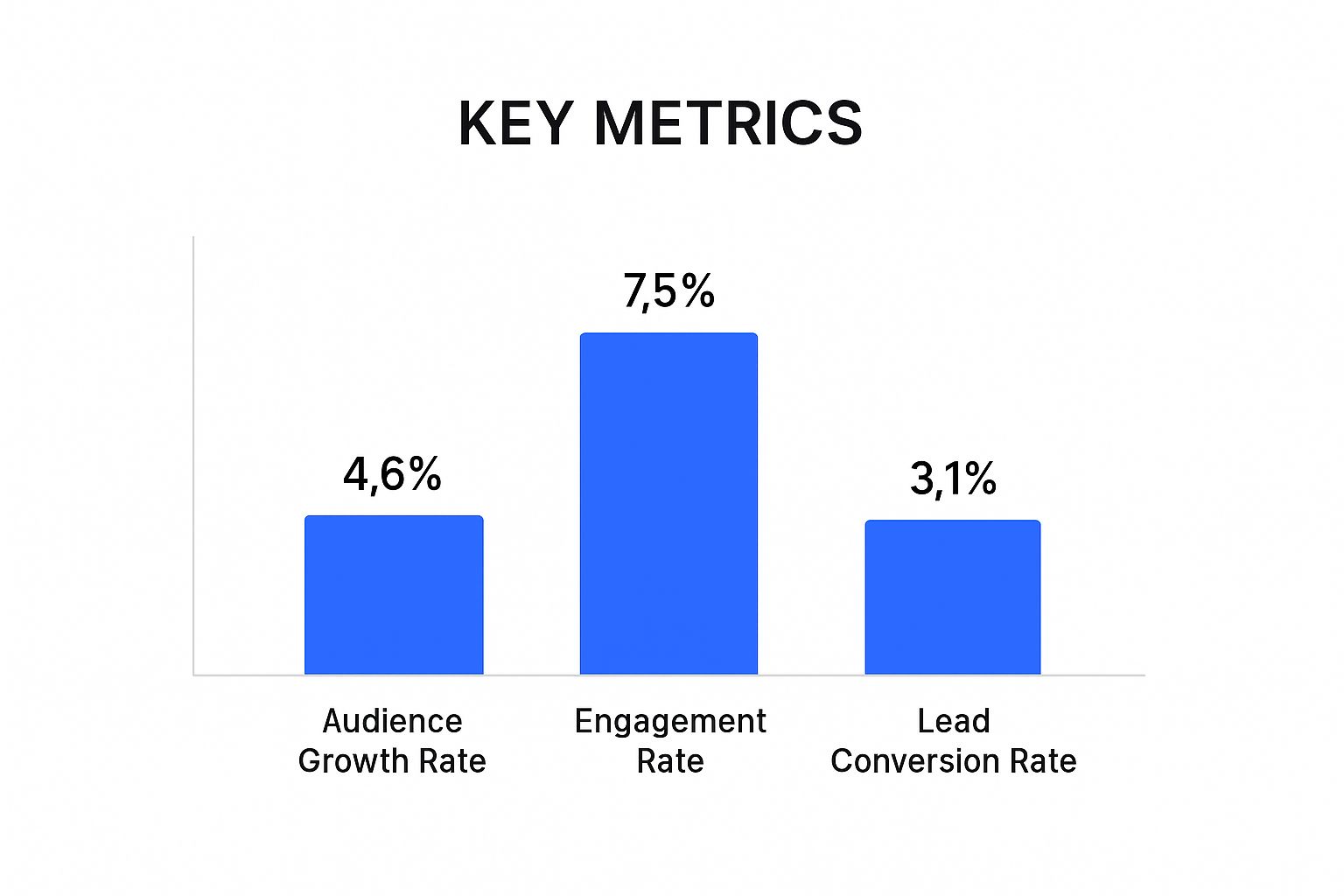A solid thought leadership strategy is so much more than just a content plan. It's the deliberate, conscious effort to build a reputation as the go-to expert in your niche—the person or brand whose insights don't just join the conversation but actively shape it. This is how you turn your hard-won expertise into a real, tangible business asset.
Why a Thought Leadership Strategy Actually Matters

Let's be honest, "thought leadership" gets thrown around so much it can start to feel a bit hollow. Too many companies treat it like a checkbox, churning out generic blog posts that just add to the digital noise instead of cutting through it. This is precisely where having a genuine strategy changes the game.
A thought leadership strategy is your roadmap. It’s what separates you from the crowd and elevates your content from random opinions to an intentional campaign designed to build authority. Without a clear plan, even the best ideas can fall flat, failing to connect with the right people or drive any meaningful business goals.
Beyond Buzzwords to Business Growth
A well-executed plan does more than just make you or your company look smart; it directly fuels business growth in several critical ways:
- It Builds Unshakeable Trust: When you consistently deliver valuable, insightful content, you naturally become a trusted advisor. That trust is the bedrock of any strong business relationship.
- It Shortens the Sales Cycle: Educated buyers make decisions faster. Your content can answer their burning questions and soothe their concerns long before they ever talk to a salesperson.
- It Justifies Premium Pricing: True experts command higher prices. When you're the recognized authority, clients expect to pay more for your proven expertise.
This isn’t just anecdotal, either. The data shows just how much this influences how people make purchasing decisions.
A comprehensive study from Momentum ITSMA and the LinkedIn B2B Institute found that an incredible 99% of buyers view thought leadership as important or critical in their decision-making process. Even more telling, 49% of those buyers said it helps them reduce the risk of making a bad choice, giving them the confidence they need to sign on the dotted line. You can dive deeper into the full research on the value of thought leadership to see the numbers for yourself.
To truly understand the difference a strategy makes, let's look at the strategic benefits and the direct business outcomes they produce.
The Strategic Impact of Thought Leadership
| Strategic Benefit | Business Outcome |
|---|---|
| Enhanced Brand Credibility | Establishes your company as a reliable, authoritative source, building deep-seated trust. |
| Increased Audience Engagement | Generates meaningful conversations and attracts a loyal following of potential customers. |
| Lead Generation & Nurturing | Attracts high-quality leads and guides them through the buyer's journey with valuable insights. |
| Competitive Differentiation | Carves out a unique position in the market, making your brand the preferred choice over competitors. |
Ultimately, a thoughtful strategy transforms your content from a cost center into a powerful revenue driver.
The Real-World Impact
Think about it this way. Imagine a B2B software company. Without a strategy, they might publish a generic article titled, "5 Benefits of CRM." It’s okay, but it gets completely lost in a sea of thousands of identical posts.
Now, consider a competitor with a sharp thought leadership strategy. They identify a very specific pain point for their ideal customer. Instead, they publish a data-backed report called, "Why Mid-Sized Retailers Are Losing 15% in Revenue to CRM Integration Gaps." This title is specific, solves a real-world problem, and instantly positions them as an expert, attracting qualified leads who see the immediate value.
The goal isn't just to participate in the conversation; it's to lead it. A powerful strategy ensures your voice is the one people seek out when they need answers.
In the end, a thought leadership strategy is a long-term investment in your brand's most valuable asset: its reputation. It’s the difference between being another voice in the crowd and becoming the definitive source of authority in your field.
Defining Your Unique Angle and Audience
Before you write a single word, we need to get something straight. The most common mistake I see people make with thought leadership is trying to be everything to everyone. It's a recipe for failure. Real authority isn't built by casting a wide net; it’s forged in a specific, well-defined niche where your expertise truly stands out.
Forget generic content. Your goal is to find that sweet spot where three things intersect: what you genuinely know inside and out, what your audience is desperately searching for, and what your competitors are completely missing.
Pinpointing Your Core Expertise
Let’s start with a little honest self-assessment. This isn't about your job title—it’s about what you actually know. What skills and hard-won insights have you picked up over your career? Don't just list topics; think about the unique spin you put on them.
- What problems do people always come to you to solve? This is a huge clue. It shows where others already see you as the go-to expert.
- What subjects get you fired up? You can't fake genuine passion, and you'll need it to stay consistent for the long haul.
- Where have you gotten real, measurable results? Think about your wins—and even your failures. These experiences give you proprietary knowledge that no one else has.
For instance, calling yourself a "social media manager" is far too broad. A much stronger angle? "An expert in using organic X (formerly Twitter) engagement to drive B2B leads for early-stage SaaS companies." See the difference? That specificity immediately signals your unique value.
Understanding Your Audience's Deepest Challenges
Once you've got a handle on your expertise, it's time to shift your focus entirely to your audience. A winning thought leadership strategy is built on a foundation of empathy. You have to get inside their world, understand their goals, and, most importantly, feel their pain points. Generic buyer personas won't cut it here.
You have to go deeper. Ask yourself:
- What are the unspoken frustrations they deal with every single day?
- What knowledge gaps are holding them back from that next promotion or big win?
- What are they secretly typing into Google or asking about in private Slack channels?
A powerful point of view doesn’t just answer questions; it anticipates them. It speaks directly to the core challenges your audience is facing, making them feel seen and understood.
This is how you create content that feels like a genuine solution, not just another blog post. It’s the difference between an article on "social media tips" and a guide on "how to build an authentic online community"—a topic demanding a much more nuanced approach. For those of you ready to dive into building that community, our detailed guide on effective social media engagement strategies is the perfect next step.
Developing a Point of View That Challenges the Status Quo
Alright, you've defined your expertise and your audience. The final piece of the puzzle is crafting your unique point of view (POV). This is your big idea—the central thesis that will be the backbone of all your content. It’s your take on the industry, a belief that might even go against the grain.
A strong POV isn't just a rehash of what everyone else is saying. It should be a compelling argument, a fresh perspective that makes people stop and think.
Here are a few ways to frame your thinking:
| POV Framework | Example |
|---|---|
| The Counter-Narrative | "Everyone says you need more followers, but I believe you only need 100 true fans to build a thriving business." |
| The Future Forecast | "While most are focused on AI writing content, the real opportunity lies in using AI to analyze audience sentiment at scale." |
| The Unseen Problem | "The biggest threat to brand reputation isn't negative comments; it's the silence from a disengaged community." |
Your POV is what makes you original. It's what makes you valuable. It ensures you're not just another echo in the chamber but a distinct voice offering real, actionable insight. This foundation is absolutely non-negotiable for any thought leadership strategy that aims to make a real impact. It’s how you go from just making content to truly leading the conversation.
Time to Build Your Content and Distribution Engine

Alright, you’ve pinpointed your unique angle and you have a solid grasp of your audience's biggest headaches. Now comes the fun part: turning those foundational ideas into a system that consistently gets high-impact content out the door. A powerful thought leadership strategy isn't built on random flashes of inspiration; it runs on a well-oiled engine.
Brilliant ideas without a real plan to bring them to life are just that—ideas. This is where we get tactical and build the machine that will carry your insights to the people who need to hear them most.
Choosing Your Core Content Formats
First things first, you need to decide which formats are the best fit for your message, your audience, and your team's bandwidth. Don't feel like you have to do everything at once. The real goal is to pick a primary format you can execute exceptionally well and then build out from there.
- In-depth Reports & White Papers: These are your heavy hitters, perfect for presenting original research or proprietary data. They scream authority but require a serious investment in research and design.
- Video Series or Webinars: If your expertise really shines through demonstration or direct conversation, video is a fantastic choice. It’s incredibly engaging and a powerful tool for building a personal brand.
- Podcasts: Ideal for deep-dive conversations and storytelling. Podcasts create an intimate connection, since listeners often tune in during their commute or personal downtime.
- Signature Articles or Blog Posts: This is the most accessible format and often the cornerstone of a great strategy. A deeply researched, insightful article can become the seed for all your other content.
From what I've seen, the most successful thought leaders master one or two primary formats before they even think about diversifying. Think of it as your flagship content.
A classic mistake is chasing every new content trend that pops up. Instead, pour your energy into creating the absolute best content in one or two key formats your audience already loves. Quality always, always wins over quantity.
The Power of Pillar Content and Repurposing
The most efficient way I know to fuel a content engine is with the pillar content model. This is where you create one massive, authoritative piece of content—your pillar—and then strategically break it down into dozens of smaller assets for different channels.
This approach is what makes content creation sustainable. You're not reinventing the wheel every single day. You're just finding new and creative ways to share your core insights. And to really keep this going, having a solid content management strategy is non-negotiable.
Here’s how this plays out in the real world:
- Your Pillar: An in-depth, 5,000-word research report titled "The State of B2B SaaS Customer Retention in 2024."
- Repurposed Assets:
- Blog Posts: Ten 500-word articles, each diving into a specific statistic or key finding from the report.
- Social Media: A 30-day content calendar of daily posts sharing data points, compelling quotes, and infographics.
- Video: A short video series where you discuss the three most surprising takeaways from your research.
- Email: A five-part email nurture sequence that walks new subscribers through the report's highlights.
This system squeezes every drop of value from your initial hard work, making sure your core message reaches a much wider audience across multiple touchpoints.
Building a Distribution Plan That Actually Amplifies
Look, creating great content is only half the battle. Your distribution plan is what ensures your ideas actually find an audience. Hitting "publish" and hoping for the best isn't a strategy; it's a prayer.
Effective distribution is targeted and proactive. This has become a huge differentiator for the most influential brands out there. In fact, when you look at how the top thought leadership producers operate, you see a massive investment in both strategic content creation and broad distribution to maximize their reach and influence.
Your distribution plan should be a smart mix of different channels and tactics:
- Owned Channels: This is your home turf—your blog, your email newsletter, and your company's social media profiles.
- Earned Channels: This means getting proactive with targeted outreach to journalists, writing guest posts on respected industry publications, and being a guest on relevant podcasts.
- Paid Channels: Use social media ads or sponsored content to push your best-performing pieces to a very specific, targeted audience.
A balanced approach ensures you're not just preaching to the choir but are actively reaching new people. By conducting a regular https://www.getreplyguy.com/blog/social-media-trend-analysis, you can spot which platforms offer the best opportunities for amplification and engagement, making sure your content lands with maximum impact. This is what keeps your engine running smoothly and your influence growing.
Measuring the Real-World Impact of Your Efforts
Great content is fantastic, but let's be honest—it's only half the battle. The other, arguably more critical, piece of the puzzle is knowing if all that effort is actually making a difference. It's time to stop chasing vanity metrics and start measuring what really matters to your business.
Think of it this way: without a solid measurement plan, you're just throwing content into the void and hoping something sticks. A smart framework, on the other hand, lets you prove the value of your work, defend your budget, and make intelligent decisions about what to do next.
Moving Beyond Vanity Metrics
First things first, we need to get real about what "success" means. A post going viral is a great ego boost, but it doesn't automatically pad your bottom line. We have to shift our focus from those surface-level numbers to metrics that tell a story about your influence and its direct link to business outcomes.
True impact is all about seeing a change in your audience's behavior. Are more of the right people—your ideal customers—paying attention? Are they taking that next step with you? Answering these questions requires a much more thoughtful approach to tracking.
Key Performance Indicators That Actually Matter
To really understand your performance, you need a balanced diet of metrics that cover the entire journey, from someone first hearing about you all the way to them becoming a customer.
Here’s what I always recommend my clients track:
- Audience Growth and Quality: This isn't just about the raw number of followers. Look at the month-over-month growth rate on your primary channels, like your LinkedIn profile or email list. But more importantly, dig into who these new followers are. Are they the decision-makers and buyers you defined back in the planning stage? Quality trumps quantity every time.
- Engagement and Influence: This is where you see if your message is actually landing. Track things like comments per post, shares, and direct brand mentions. I always look for high-quality engagement—real, thoughtful conversations in the comments are a powerful sign that you're hitting a nerve. For a deeper dive, our guide on how to measure social media engagement is a great resource.
- Lead Generation and Attribution: This is where the rubber meets the road. You need to know how many qualified leads are coming directly from your content, whether it's from a gated white paper, a webinar registration, or a simple "contact us" form.
The image below gives a nice visual overview of these core metrics.

As you can see, tracking these metrics together—Audience Growth, Engagement, and Lead Conversion—gives you a complete picture of how your strategy is performing from top to bottom.
Connecting Content to Commercial Value
The ultimate goal here is to draw a straight line from a blog post or a LinkedIn article to a signed contract. This is how you prove the commercial value of your thought leadership to anyone who asks.
Don't just take my word for it. Research from Edelman and LinkedIn found that 54% of C-suite executives spend at least an hour a week reading thought leadership content. The ROI is real.
To help you track what matters, I've put together a table breaking down the most important KPIs.
Thought Leadership ROI Metrics
This table breaks down the key performance indicators you should be tracking to measure the success of your strategy, from brand awareness all the way to revenue.
| Metric Category | Example KPIs | What It Measures |
|---|---|---|
| Brand Awareness | Share of Voice, Brand Mentions, Follower Growth | Your visibility and presence within your industry. |
| Audience Engagement | Comments, Shares, Likes, Time on Page | How well your content resonates with your target audience. |
| Lead Generation | Gated Content Downloads, Webinar Sign-ups, Demo Requests | The ability of your content to convert readers into potential customers. |
| Sales Enablement | Content-Influenced Leads, MQL-to-SQL Conversion Rate | How effectively your content supports the sales process. |
| Revenue Impact | Customer Acquisition Cost (CAC), Lifetime Value (LTV), ROI | The direct financial return generated by your thought leadership efforts. |
By tracking these KPIs, you can move from simply counting views to understanding the real business impact of your work.
Pro Tip: Your CRM is your best friend here. By using UTM tracking links in your content and connecting your marketing platforms, you can literally follow a lead's journey from the moment they read your article to the day they sign on the dotted line.
This level of attribution completely changes the conversation. You’ll go from answering "How many likes did we get?" to "Our thought leadership program generated $X in revenue last quarter." That’s how you prove your strategy isn't just a marketing cost—it's a powerful engine for business growth.
How to Scale Your Strategy for Long-Term Success

A truly effective thought leadership strategy isn’t a one-and-done campaign. It’s a living program that should grow and evolve right alongside your business. While getting that initial momentum is exciting, the real win is building a system that sustains its influence for years. This means looking past short-term gains and focusing on genuine, long-term scalability.
The key is to shift your strategy from a top-down marketing function to something that's baked into your company culture. When expertise is genuinely celebrated and shared across the entire organization, your thought leadership becomes infinitely more powerful and sustainable.
Build a Culture of Expertise
Let’s be honest—your company is probably packed with subject matter experts (SMEs) whose incredible insights rarely make it outside the building. They’re in engineering, customer support, product development, and sales, each holding a unique and valuable perspective on your industry and what your customers are up against. Your first job in scaling is to tap into this internal goldmine.
But how do you convince a busy engineer or a client-facing consultant to contribute? You make it incredibly easy and worthwhile for them.
- Create a clear, low-friction process. This could be as simple as a dedicated Slack channel for content ideas, a monthly brainstorming session over coffee, or a basic form where they can drop a raw idea.
- You do the heavy lifting. Your content team’s role is to take those rough gems and polish them. An SME shouldn't be expected to write a perfect 1,500-word article. Instead, book a 30-minute interview and have a writer turn that conversation into a compelling piece of content.
- Recognize and reward them. Publicly celebrate every contribution. Feature your internal experts on the company's social media, give them shout-outs in all-hands meetings, and show everyone how their insights are driving real business results.
When you create this kind of supportive environment, you move from having one or two designated "thought leaders" to nurturing a genuine culture of expertise.
Use Data to Refine and Pivot
Once your strategy is up and running, you'll start collecting a ton of performance data. This information is your roadmap for what to do next. Don't just keep creating content because it's on the calendar; use your data to double down on what works and be brave enough to cut what doesn't.
Look at your metrics, but with a new perspective.
- Identify your greatest hits. Which content formats always get the most engagement? Do your in-depth data reports crush your video interviews? Which core themes are bringing in the most qualified leads?
- Find the hidden gems. Look for that one piece of content that blew up unexpectedly. What was different about it? Was it the topic, the tone, or the distribution channel? These outliers often hold the key to your next big win.
- Listen to your audience. Pay close attention to the comments and questions on your content. These are direct requests. If you see multiple people asking about the same specific topic, that's a clear signal to create content that gives them the answer.
Your data isn't just for reporting; it's for making decisions. A scalable thought leadership strategy is agile. It constantly learns from its own performance and adapts to better serve your audience, ensuring your voice stays relevant.
Refresh Core Themes and Experiment
The market doesn't stand still, and neither should your content. What was a groundbreaking insight two years ago might be common knowledge today. A huge part of scaling is committing to continuous evolution.
Revisit Your Content Pillars Annually Set aside time each year to reassess your main content themes. Are they still hitting the mark? Have new challenges or trends emerged in your industry? Refreshing your core messaging ensures you continue to lead the conversation, not just repeat old talking points.
Experiment with New Formats Audience preferences shift. While long-form articles may have been your bread and butter, maybe your audience is now gravitating toward short-form video or interactive tools. Dedicate a small slice of your resources—say, 10-20%—to experimenting with new content formats. This lets you test new waters without abandoning what you already know works.
By consistently encouraging your internal experts, digging into your performance data, and staying adaptable, you'll build a thought leadership strategy that doesn't just launch—it lasts. It becomes an enduring asset that builds on its own success, solidifying your influence for the long haul. A great way to boost these efforts is through a well-defined social media engagement strategy that can place your expert content right in the middle of the conversations that matter most.
Common Questions About Thought Leadership
Even with a solid plan, it's completely normal to have some lingering questions before you dive headfirst into a thought leadership strategy. People often wonder about the real-world timelines, the budget you actually need, and what this all really means. Let's get into some of the most common questions we hear and give you some straight-up answers.
How Long Does It Realistically Take to See Results?
This is usually the million-dollar question. The honest answer? It’s not an overnight thing. Building genuine authority and trust takes time and consistent effort. You might see some encouraging signs early on—like better engagement or a bump in followers—within the first 3-6 months.
But if you're looking for a measurable impact on things like lead generation and sales, you need to be patient. A realistic timeline for seeing significant, trackable results is typically 12 to 18 months of consistent, high-quality work. That's the time it takes for your ideas to spread, for search engines to catch on, and for your audience to truly see you as a go-to expert.
Think of thought leadership as a long-term investment in your reputation, not a quick marketing campaign. The momentum you build in year one pays massive dividends in year two and beyond.
What Is the Real Difference Between Thought Leadership and Content Marketing?
This is a fantastic question, because the line between them can feel a little blurry. They're definitely related, but they serve different purposes.
Here’s the simplest way I can put it: all thought leadership is a type of content marketing, but not all content marketing is thought leadership.
Content Marketing is the broader practice. It’s all about creating and sharing useful stuff—like how-to articles, videos, or case studies—to attract and engage your audience. Its main job is to support the buyer's journey.
Thought Leadership is a much more specialized slice of that pie. Its goal is to establish you as an authority with a unique, forward-thinking perspective. It doesn't just answer old questions; it asks new ones, challenges the status quo, and shapes the conversation in your industry.
The easiest way to tell them apart is to look at their purpose. Content marketing usually answers the "what" and the "how." A powerful thought leadership strategy is all about the "why" and the "what if."
Can I Build Authority with a Small Budget?
Absolutely. A massive budget is nice to have, but it's definitely not a requirement for building real influence. In fact, some of the most respected voices out there started with little more than a strong point of view and a commitment to showing up consistently. For smaller businesses or individuals, it's all about being smart and resourceful.
Here are a few budget-friendly moves that pack a punch:
Pick One Playground. Don't spread yourself thin trying to be everywhere. Choose one social platform where your ideal audience hangs out—like X (formerly Twitter) or LinkedIn—and go all in on mastering it.
Lean on Your Personal Brand. Your unique experiences, stories, and personality are your secret weapons. No amount of money can replicate you. Turn your journey, including the wins and the losses, into content that builds a real connection.
Team Up with Peers. Partner with other experts in your field for joint webinars, interview swaps, or social media collaborations. This is a fantastic, no-cost way to get in front of a new audience and borrow some credibility.
Engaging in conversations on X, for example, is a powerful, free way to get your name out there. If you're new to the platform, checking out some social media best practices for Twitter is a great place to start. At the end of the day, the power of your ideas will always matter more than the size of your wallet.
Ready to accelerate your authority on X? Reply Guy is a powerful Chrome extension that helps you find trending conversations and craft high-impact replies in minutes. Stop scrolling endlessly and start engaging smarter to grow your audience effortlessly. Get lifetime access to Reply Guy today!
